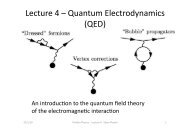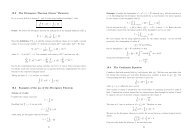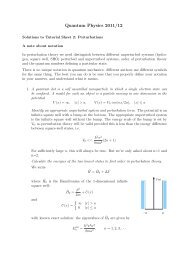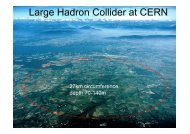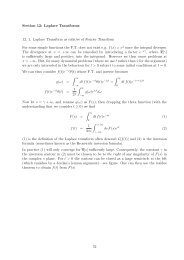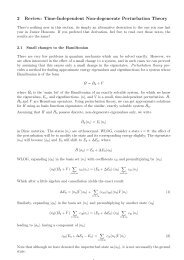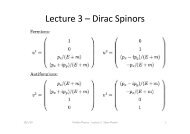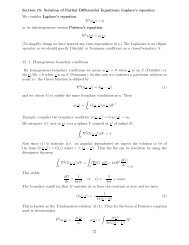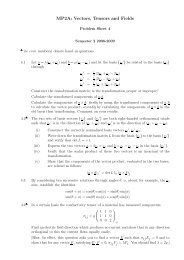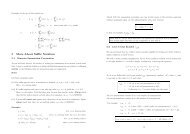2.4 Active and Passive Transformations
2.4 Active and Passive Transformations
2.4 Active and Passive Transformations
Create successful ePaper yourself
Turn your PDF publications into a flip-book with our unique Google optimized e-Paper software.
<strong>and</strong> are also unique. For example if there exists another operator T with the sameproperties as P, ie Tu = u, Tv = 0, then for any vector w ≡ µu + νv + λu × v wehave(P − T)w = (µu + 0 + 0) − (µu + 0 + 0) = 0 ,(as (P(u × v)) i = P ij (u × v) j = (u i u j /u 2 ) ǫ jkl u k v l = 0) <strong>and</strong> hence T = P.⃗e2θ⃗e ′ 2⃗x⃗e1<strong>2.4</strong> <strong>Active</strong> <strong>and</strong> <strong>Passive</strong> <strong>Transformations</strong>• rotating a vector in a fixed basis is called an active transformation, x → y withy i = R ij x j in {e i} basis.⃗e3, ⃗e ′ 3⃗e ′ 1• rotating the basis keeping the vector fixed is called a passive transformation,{e i} → {e ′ } or x i → x ′ i = l ij x j .Let us set R ij = l ij then numerically y i = x ′ i , <strong>and</strong> consider (for simplicity):1. Rotation of vector about z-axis:⃗e3⃗e2⃗yθR ij (θ, e 3) = δ ij cosθ + (1 − cosθ)δ i3 δ j3 − ǫ ijk δ k3 sin θ⎛⎞cosθ − sin θ 0= ⎝ sin θ cosθ 0 ⎠ ,0 0 1(as n i = δ i3 ). This is an active transformation through angle θ.2. Rotation of basis about z-axis:ore ′ i = l ije j≡ R ij e j,e ′ 1= cos θe 1− sin θe 2e ′ 2= sin θe 1+ cosθe 2e ′ 3= e 3.This is a passive transformation through angle −θ:⃗x⃗e1Hence:<strong>Active</strong> rotation of x through angle θ is the same as passive rotation of basis vectorsby an equal <strong>and</strong> opposite amount.<strong>2.4</strong>.1 Introduction to Lie AlgebrasRecalling, as discussed previously, rotation of a vector in a fixed basis is y = RxwhereR ij (θ, n) = δ ij cosθ + (1 − cosθ)n i n j − ǫ ijk n k sin θ .For an infinitesimal rotation δθ → 0 we thus have (upon exp<strong>and</strong>ing or using theprevious geometrical argument)withSo⎛ ⎞0 0 0T 1 = i ⎝ 0 0 −1 ⎠ ,0 1 0R ij (δθ, n) = δ ij − ǫ ijk n k δθ + O(δθ 2 )= δ ij − in k (T k ) ij δθ + . . . ,(T k ) ij = −iǫ ijk .⎛ ⎞0 0 1T 2 = i ⎝ 0 0 0 ⎠ ,−1 0 0⎛ ⎞0 −1 0T 3 = i ⎝ 1 0 0 ⎠ .0 0 0The T i are called the generators of infinitesimal rotations about basis vectors e i(the−i is conventional so T i are Hermitian, T †i ≡ Ti T ∗ = T i ).So infinitesimal rotation through angle δθ about n isR(δθ, n) = 1 − iδθ n · T .2122
• If [A, B] def= AB − BA is the commutator, then commutation relations for the{T i } are given by[T i , T j ] = iǫ ijk T k .(Proof: use product of epsilons several times! See example sheet.)cf rotations in Quantum Mechanics.• The commutation relations between the generators are called the Lie Algebraof the group; ǫ ijk are called the structure constants.For finite transformations use the relation(e x = lim 1 + x ) N,N→∞ N(which may be proved by writing (1+x/N) N = exp(N ln(1+x/N)) = exp(N(x/N +O(1/N 2 ))) = exp(x)(1 + O(1/N))).If we extend this result to matrices, by setting δθ = θ/N, where θ is finite, then(R(θ, n) = lim 1 − i θ ) NN→∞ N n · T ,ie we may consider a finite rotation as being built from many infinitesimal rotations.This then gives 1 R(θ, n) = exp ( −iθn · T ) .To prove the equivalence of this result with the original result for a finite transformationis not completely trivial – see example sheet.Rotations in 3 dimensional Euclidean Space form a Lie Group SO(3) where S forSpecial, det R = +1 <strong>and</strong> O for Orthogonal, RR T = 1.Chapter 3Cartesian Tensors3.1 Definition <strong>and</strong> Transformation PropertiesFor any vectors a <strong>and</strong> b we havea ′ i = l ij a jb ′ i = l ij b j ,where L = (l ij ) is the rotation matix from frame S to frame S ′ , with LL T = I = L T L,det L = +1. Note that we are using the passive picture again.We can re-define a vector a as an entity having 3-components with respect to (wrt)any frame of reference with the property that if a i are the components wrt S <strong>and</strong> a ′ iare the components wrt S ′ then a ′ i = l ij a j .Consider now the 9 quantities, a i b j :(a i b j ) ′ def= a ′ ib ′ j = l iα a α l jβ b β= (l iα l jβ ) (a α b β ) .(α, β are dummy indices.) So these 9 quantities obey a particular transformationlaw under the change of frame of reference S → S ′ . This motivates our definition ofa tensor.1 By definition,e A = 1 + 1 1! A + 1 2! A2 + 1 3! A3 + . . . .3.1.1 Definition of a tensorWe thus define a tensor of rank 2, T, as an entity having 9 components wrt anyframe of reference with the property that if T ij are the components wrt S <strong>and</strong> T ij′are the components wrt S ′ thenT ′ij = l iα l jβ T αβ ,2324






